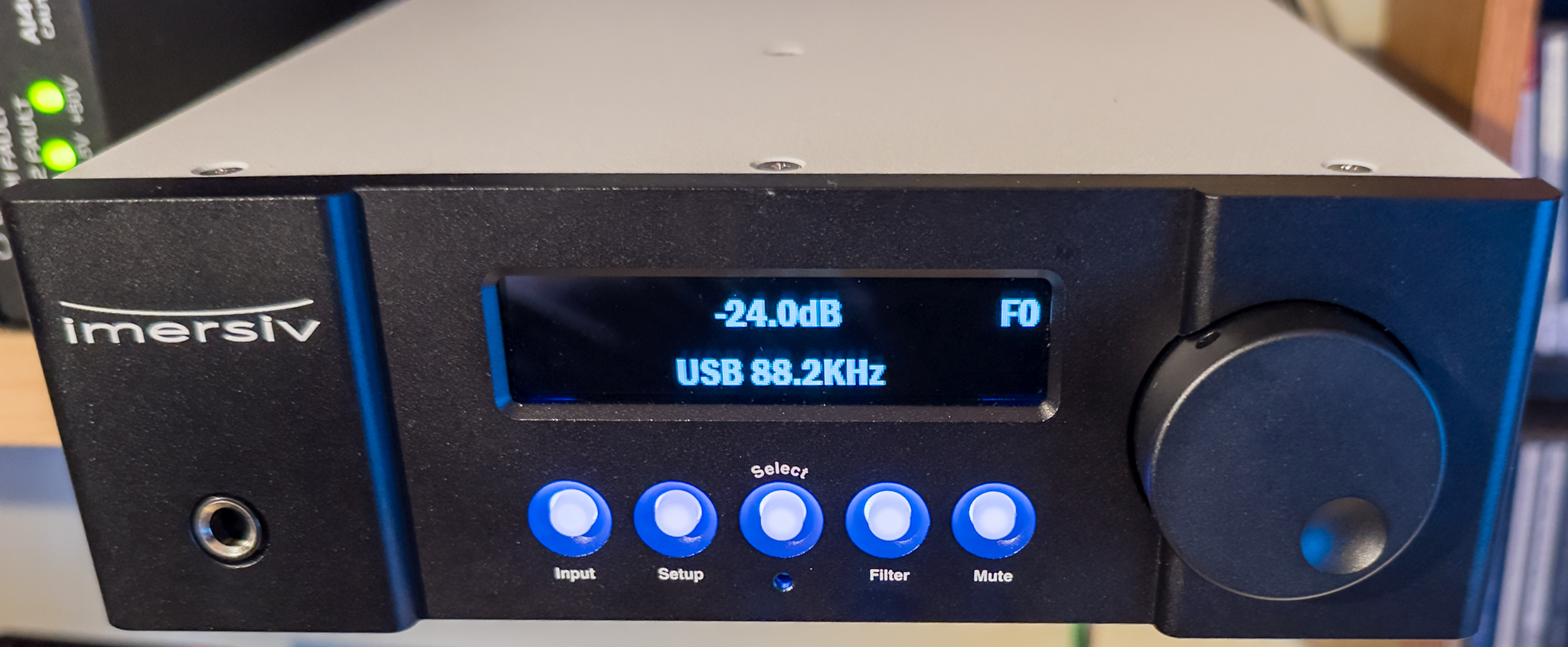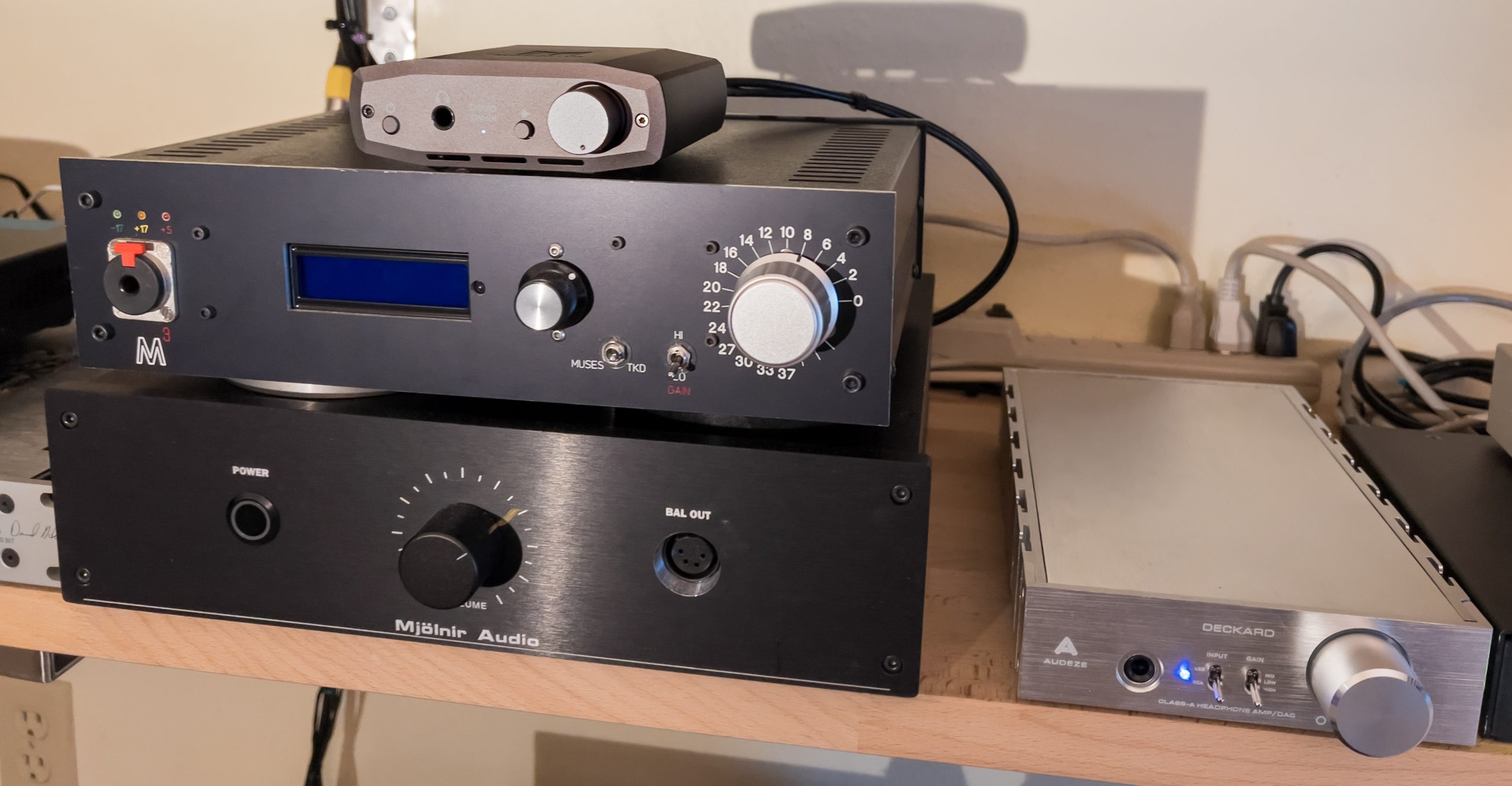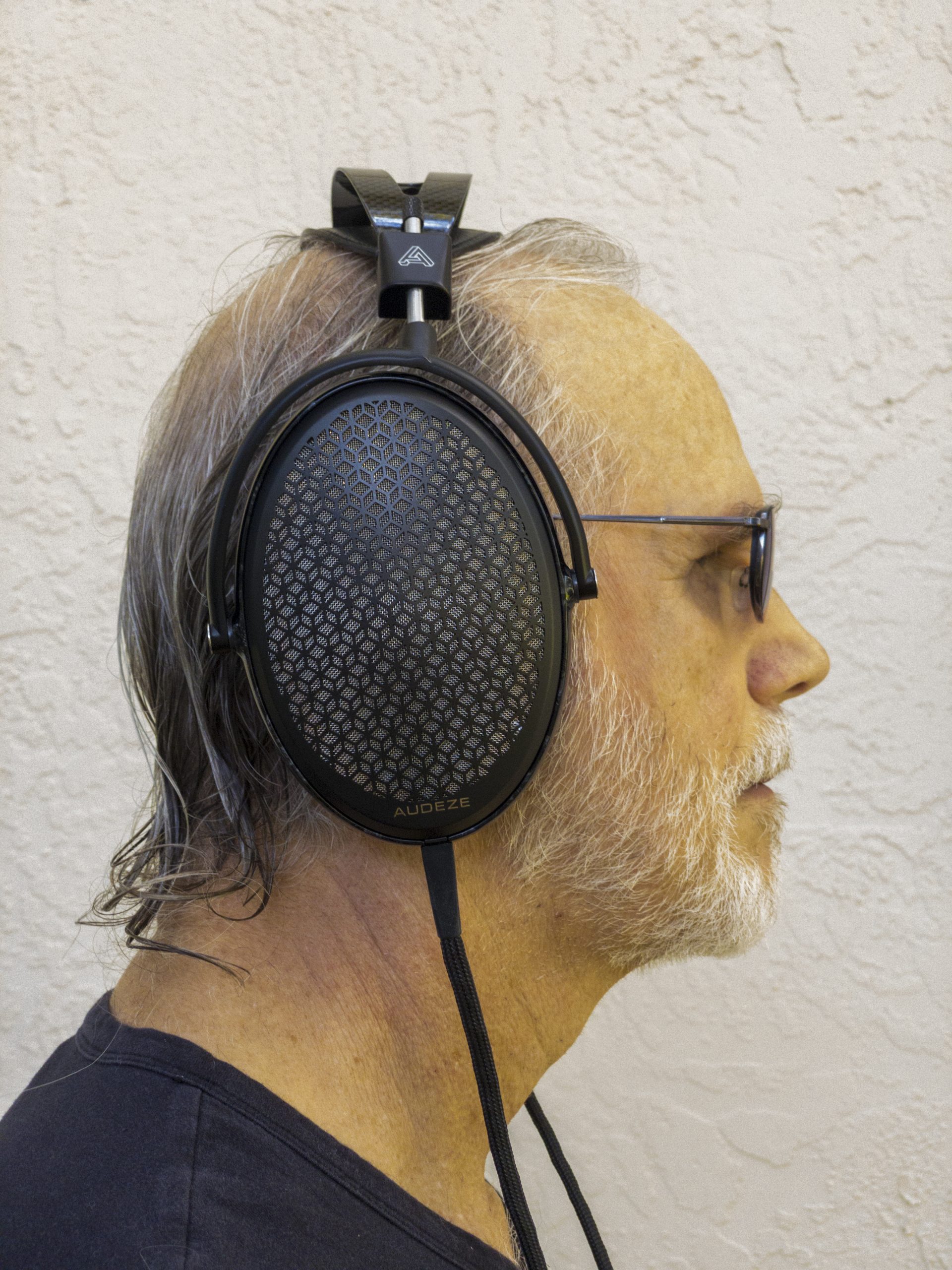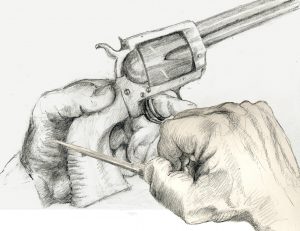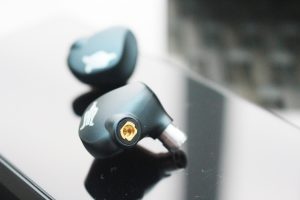Sensitivity
First, I measured the sensitivity of the Audeze CRBN, comparing it to the Stax 007. My headphone measurement instrument is the Mini DSP "Ears," which is far from a standard. However, using my ACO Pacific SPL calibrator, I was able to calibrate the Mini DSP for SPL at 1kHz within about a dB, I suspect. The CRBN's output is about equal to the Stax 007 Mk II with a 100-volt signal at 1kHz. If you are making measurements or critical judgments, I suggest you discharge the phones as they can retain enough charge to subtly affect the channel balance or sensitivity.
Absolute Polarity
Using a special polarity test signal, I determined that the Audeze CRBN inverts absolute polarity. This was so surprising that I repeated the measurement several different ways, using a different test signal, different test microphone and different methods. In all cases I got the same results: The headphone is inverted. I did confirm my signal path is non-inverting from the digital file all the way to the Mjolnir amp's + and - output terminals. So I have no choice but to declare that the Audeze CRBN inverts absolute polarity. But guess what, guys:
- The Stax 007 Mk2 also invert absolute polarity! Has anyone ever remarked about that or noticed an issue?
- I have not been able to notice a difference when switching polarity using an electrostatic headphone. I have been able to detect a polarity inversion using a moving coil headphone. Does this mean that a $100 moving coil headphone is more revealing than a $4500 Electrostat? Au contraire, I believe the reason that polarity differences are inaudible with stats is that they are so symmetrical in push versus pull and so linear compared to a moving coil, that there are no differences in distortion with either polarity. There is enough evidence accumulating about absolute polarity to indicate that what you are hearing is due to non-linearities in your transducers—they respond differently to positive going signals than negative. But this is not the case with the perfectly-symmetrical CRBN transducers. So if you think absolute polarity is a big deal, maybe it's caused by problems with your loudspeakers.
- A challenge to my readers: If you find any musical source or recording that you believe reveals polarity differences on stats, tell me about it and I'll check it out. I'm willing to keep an open mind on this conundrum. But meanwhile, I believe that absolute polarity is a non-problem problem with stats. And besides, you can correct it by simply reversing two pairs of wires or pushing the polarity invert switch available in several DACs or in software.
Frequency Response
Dr. C, the genius behind most of Audeze's designs, provided a factory measurement of a CRBN using a Gras Kemar head. Using Acourate software by Audio Vero, I averaged the response of the two ears and applied 1 octave smoothing to the CRBN measurement. I then normalized the level of the Harman curve to match the level of the CRBN response in the lower midrange. This allows us to effectively compare the CRBN response to the Harman shape. This chart superimposes the two frequency response curves (Figure 2A, with Harman in green and CRBN in blue).
Fig. 2A: CRBN frequency response, average of two ears, 1 octave smoothing, Gras Kemar head (blue), Harman curve (green).
The CRBN response is close to the basic shape of the Harman curve, yet there are differences that would be clearly audible and frankly, correspond to my own reactions to the Harman curve. The bass response of the CRBN is remarkably smooth, flat and extended. A 2 dB tilt EQ at 20Hz returning to 0 at 90 will yield measurably flat bass all the way up to about 300Hz. As you saw, Bob's EQ has about a 2 dB bass boost on top of this measured flat response. No professional listener so far who has listened to Bob's EQ with the reference tracks has felt a lack of bass. Perhaps my professional listeners play music at a louder level than the consumers who helped develop the Harman curve, so typical consumers prefer more bass boost. SPL has an effect on bass judgment, as always.
Above 400 Hz the Audeze CRBN measurement begins the pinna rise that we expect from an artificial ear, rising slightly earlier than Harman and peaking at an earlier frequency. This difference is the hardest to interpret and I've only begun to study it. I think the differences from about 3kHz to about 11kHz are significant: the Harman curve is significantly brighter in that critical region, in fact, too bright for my ears and compared to the reference loudspeakers. This is evidenced by Bob's EQ being very flat all the way up to about 11kHz and that the equalized phones sound accurate on the musical references without needing to alter their treble. Above about 11kHz, Harman has a severe roll-off, which I'm not sure is a good thing, based on my reference listening. In that region I apply only a slight rolloff.
I also measured my own sample of CRBN with the Mini DSP EARs. Although it is not a standardized measurement tool, the measurement revealed some valuable data. On the Mini DSP, with 1/6 octave smoothing, the two drivers measured within a fraction of a dB of each other throughout the entire frequency range (not shown), nearly zero difference between channels! This shows remarkable precision in the manufacture of the CRBN, since the two Mini DSP artificial ears are bilaterally symmetrical. A channel match this precise should result in a very consistent, well-focused stereo image.
Next, I compared the Audeze CRBN frequency response against the Stax 007 with the EARS measurement jig, left ear only shown, Figure 3. I repeat that the EARS is not a standardized measurement device, but we can learn something when comparing the two electrostatic headphone brands with the same jig. In the bass range, we can see that the Stax (red trace) looks a little kinky while the Audeze CRBN (green trace) looks flatter and more extended. And in the high frequency range, the Stax measures significantly brighter. The question of the hour is: Which HF measured response is more ideal? How flat should a headphone measure above 10kHz? My money is on a slight HF roll-off, since my EQ is totally satisfying to my users and uses minimal HF roll-off. However, I've never been able to find a totally satisfying EQ for the Stax, at low or high end.
Fig. 3: Frequency response, left ear, using MIni DSP EARS. Red = Stax 007 Mk2. Green = Audeze CRBN. 1/6 octave smoothing
Harmonic Distortion
Figure 4 shows a measurement of Audeze CRBN harmonic distortion at approximately 80 dB SPL using Mini DSP EARs:
Fig 4: Audeze CRBN THD at approximately 80 dB SPL. Red = Left, Green = Right
This is an unprecedented achievement: At nominal 80 dB SPL, Audeze CRBN Total harmonic distortion is below 2% from 20Hz on up, below 1% above 30, below 0.5% until 80Hz, and below 0.2 % for the majority of the spectrum. It rises in sync with the measured frequency response rise but never exceeds 1% all the way to 10 kHz. Left and right channel distortion are almost perfectly matched, with just a pinch more in the right channel circa 30Hz. I don't think there's a magnetic technology that can come close to the CRBN's vanishingly low bass distortion figures.
Mjolnir KGSS HV Carbon Amplifier Measurements
Perhaps the weakest link in the performance of Stax headphones has been the Stax amplifiers, which routinely have not produced enough satisfactory output to drive Stats loudly and with the kind of punch that we expect from dynamic phones. I've found Stax solid-state amps can sound a little harsh in the high end. In my opinion, Stax tube amps sound nicer but do not produce enough satisfactory output. But a number of third party amps do the trick. I've performed a complete set of measurements on the Mjolnir, but since this is a headphone review, I'll just show some measurements that outline its exceptional performance as an electrostatic amplifier. The manufacturer claims "this is the first electrostatic amp in the world to use SiC FET output devices which are as close to triodes as transistors can get." Translation: a warmer sounding amp, more suitable for dealing with bright transducers. Square wave, IM distortion, noise and frequency response measure very well (not shown).
Mjolnir Harmonic Distortion
I do not have a simulated capacitive load. These measurements are made with a high impedance resistive load. Assuming that the amp has fairly low output impedance, it's unlikely that a capacitive load would have any effect. Figure 5 shows that when producing a voltage that would drive the Audeze CRBN to 97 dB SPL, the Mjolnir's harmonic distortion at 1kHz consists strictly of 2nd harmonic at the equivalent of 16 dB SPL! This is effectively inaudible, especially when masked by the fundamental. The rise in the noise curve above 40kHz is due to the noise shaping in the Prism converter I used to measure the signal.
Fig. 5: Mjolnir KGSS HV Carbon 1 kHz Harmonic distortion at the equivalent of 97 dB SPL
The amplifier remains clean until it would yield 113.4 dB SPL. One dB above that it clips severely, producing well over 1% THD, so the practical limit driving these phones before the amp clips is 113.4 dB SPL. The amp is then producing a formidable 467 volts, which explains why an electrostatic headphone amp is so special. Obviously, this is plenty more headroom than any listener may require, but I like to see my gear overperform. Good headroom means the amp can cleanly reproduce instantaneous transients. To measure THD at such high voltages, I built a special attenuator to feed the measurement converter. Figure 6 shows the harmonic distortion the amp would produce at the voltage that would produce 113.4 dB SPL, a very low 0.025% THD. This was measured using my Cranesong converter, which does not show the noise shaping signature. As you can see, the harmonic content grows as the amplifier approaches clipping. The highest level harmonic is 90 dB below the fundamental, which would put it at a very low 23 dB SPL. If you ever play this amp and phones this loudly, even on short duration peaks, you'd go deaf before the amplitude of these extra harmonics becomes meaningful. But this degree of clean headroom ensures that you will be able to reproduce the dynamics of any kind of music you throw at this Electrostatic amplifier.
Fig. 6: Mjolnir KGSS HV Carbon amplifier, 1kHz Harmonic distortion at 467 volts output, which would yield 113.4 dB SPL in the Audeze CRBN
About Bob
Bob Katz has been a recording, mixing and mastering engineer since 1971, making audiophile and Grammy-winning recordings. He has written a best-selling book: Mastering Audio: The Art and the Science, now in its third edition. He's president and mastering engineer at Digital Domain, a Life Fellow of the Audio Engineering Society, and a lifetime audiophile. Visit Bob's website at https://www.digido.com.









